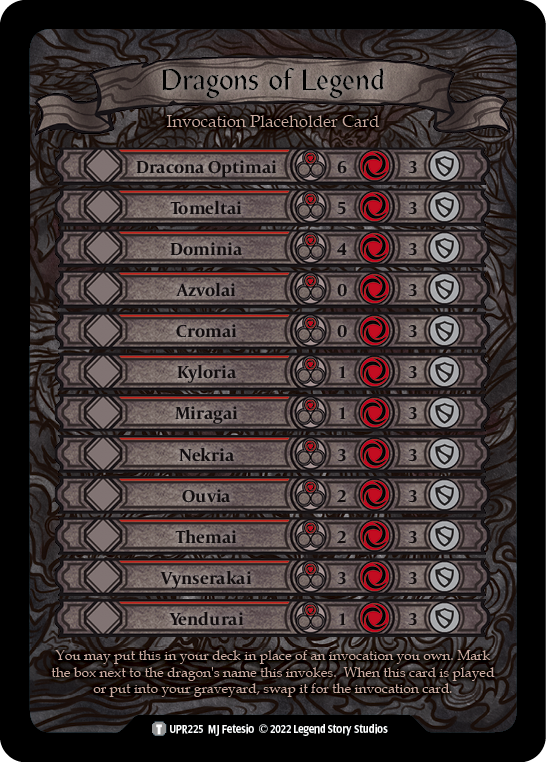Dragons of Legend
Introducing Flesh and Blood’s first placeholder card: Dragons of Legend

With the introduction of Double Faced Cards (DFC) comes both new mechanics and challenges to the practical logistics of gameplay. The placeholder card is designed to alleviate some of the concerns regarding the impact of DFC in typical tournament play.
How do placeholder cards work?
The placeholder card lists all of the dragons by name in Uprising, and specifies the properties of their invocation face: color bar, pitch, cost, and defense. A placeholder is designed to represent one of these cards in the deck, without the DFC being considered marked (if it is unsleeved or in a clear sleeve) and without requiring the player to unsleeve the DFC just to flip it over.
Typically, a player makes a mark in the box next to the single DFC they want the placeholder to represent. Then they sleeve the card as a card to be used in their deck and the DFC it represents in a different sleeve. When the player draws this card and decides to play it, or when it goes to the graveyard (such as after defending), the player then swaps it out with the actual DFC it represents (in the correct orientation). If the DFC would go back into the deck/hand/arsenal, the placeholder card can be swapped in again to represent the card in the deck/hand/arsenal.
What else can I do with Placeholder cards?
During a draft, DFCs pose an information issue where players who look at other players while they make their pick may spot the back-face of a DFC, or even just the glimpse presence of a DFC in a pack because of a non Flesh and Blood card back. In less competitive events, this is less of an issue as there is a relaxed restriction on table talk to make the event more social. At Professional REL events, draft packs can be repackaged (and perhaps stamped) with the placeholder cards replacing any DFCs in each pack. If a player drafts a placeholder card, when the drafting is completed, they are then given the DFC that it replaced in the pack.
Are there any alternatives to the placeholder cards?
Yes. Placeholders provide a convenient low-cost solution for the majority of players who want to ensure the longevity of their DFC. However, players may use an alternative solution to DFC. Players may sleeve the DFC to use its front-face, and then have an identical DFC sleeved to use the back-face. Whenever the front-face DFC in the deck would be flipped, it is swapped out with back-face DFC; then when it would be flipped back again, the front-face DFC is swapped back in to replace the back-face DFC.
However, this does require the player to own two of the same DFC to be used in this way, and they must ensure that the front-face DFC is sleeved alike with the other cards in their deck, and the back-face DFC is explicitly not. This will be covered in more detail with future updates to the Tournament Rules and Policy and Penalty Guidelines.
Any final thoughts?
Double faced cards are just the latest addition of game mechanics in Flesh and Blood to push the boundaries of what is possible with the game engine. As with all drastic new additions to the game, there are more challenges to consider outside the face value of the cards. That being said, placeholder cards give us the tools to address some of these challenges in a player-friendly way to ensure a better gameplay experience.